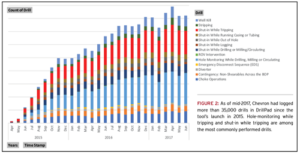HSE&T Corner: Chevron develops software tool for conducting, evaluating well control-related drills, seeks to share it with wider industry
By Kelli Ainsworth, Associate Editor

Well control, like safety, is too important to be leveraged as a competitive advantage. That’s why Chevron is planning to share with the wider industry a tool – called DrillPad – that the operator launched in 2015 to assist with the planning and tracking of well control drills. The software was developed as part of Chevron’s WellSafe assurance program, which certifies that every one of the company’s business units, wells and contracted rigs adheres to a uniform set of standards. “Sharing DrillPad so that we don’t have well control events that result in loss of containment is absolutely in our best interest,” said Jeff Smith, WellSafe Systems Manager. “We see it as good for the industry and, consequently, we’d just as soon give it to the industry.”
WellSafe was developed in the aftermath of significant well control events that occurred in the industry and at Chevron, and implementation began in 2014. Since then, the company has seen a greater than 99% compliance rate in both well planning and execution requirements, Mr Smith said, adding that the severity of well control events has also been reduced. Chevron has had no well control events that involve a loss of containment at the surface or underground since the launch of WellSafe and DrillPad.
WellSafe Examiners, who report to the General Manager of Drilling and Completions Assurance and are not affiliated with a specific business unit, verify that the well planning and execution meet Chevron standards. Additionally, under WellSafe, the drilling and completion operations in each of Chevron’s business units undergo an external assessment every 18 to 24 months. The external assessments ensure that rigs have rig-specific procedures in place for well control-related activities. These activities include monitoring the well while tripping pipe, monitoring the well while drilling ahead, and well shut-in and kill procedures. Well control equipment and maintenance, inspection and testing programs are also reviewed as part of the external assessment.
DrillPad is the primary tool for evaluating and tracking crew competency through drills. When a Chevron drill site manager (DSM) and the rig’s toolpusher are ready to run a drill, DrillPad provides guidelines for the drills. Working together, the DSM and rig toolpusher select from among the major drill types, such as well kill, shut-in while tripping and shut-in while drilling (Figure 2).
DrillPad also supplies additional complications that can be incorporated into the drill. For instance, during a drill for shut-in while tripping, potential complications include the well continuing to flow, gas migration and tripping while taking losses. Further, a drill can be conducted announced or unannounced. All crew members who have a role in the operation are involved in the drill. Rig-specific procedures define what role, if any, a given individual in the crew has.
 Rig crews are expected to perform well control drills during every hitch, Mr Smith said. “The expectation is that the drills are relevant to the operations that are happening on the rig at that time. If they’re drilling ahead and are going to be drilling ahead the whole hitch, the drills will be related to hole monitoring while drilling, hole monitoring while tripping and potentially shut-in while tripping.” As of mid-2017, Chevron had logged more than 35,000 drills in DrillPad.
Rig crews are expected to perform well control drills during every hitch, Mr Smith said. “The expectation is that the drills are relevant to the operations that are happening on the rig at that time. If they’re drilling ahead and are going to be drilling ahead the whole hitch, the drills will be related to hole monitoring while drilling, hole monitoring while tripping and potentially shut-in while tripping.” As of mid-2017, Chevron had logged more than 35,000 drills in DrillPad.
Post-drill, the DSM then chooses a set of questions to review with the crew. DrillPad provides 20 to 30 questions for each type of drill. “The purpose of the questions is to start conversations that allow us to evaluate competency,” Mr Smith said.
Throughout the drill and the Q&A session afterwards, the DSM and toolpusher evaluate the overall performance of the participating crew members. “They’re looking at whether the crew had knowledge of what they were doing, if they took the appropriate action and if they acted without being told what to do,” Mr Smith said. The crew’s performance during the drill is also assessed for compliance against rig-specific procedures, which are developed by the drilling contractor. “Even if they perform competently, but it is not consistent with the rig-specific procedures, then there’s a problem. Either the procedure needs to be updated or the crew needs more competency evaluation.”
Crews are scored on a scale of zero to three, with zero and one representing below-average scores. A two is an average score and indicates that the crew has the knowledge and competency needed and followed rig-specific procedures. A three is considered above average and indicates that the crew demonstrated not only competency but also superior communication skills. “If performance is less than satisfactory, then operations cease until competency is improved and can be demonstrated, typically in the form of repeating the drill,” Mr Smith said.
Scores from each drill are input into and tracked from DrillPad. With results from more than 35,000 drills now in the system, Chevron is using this data to identify trends. For instance, the operator can see if one rig or drilling contractor has consistently higher scores than other rigs or other drilling contractors. “This isn’t a conversation about who’s good and who’s bad,” Mr Smith emphasized. “The conversation is why is this crew or contractor doing better than that crew or contractor, what are they doing differently, and how can we take what they’re doing and give it to others to get better overall?”
While DrillPad can be an enabling tool, Mr Smith said, the software alone will not yield competency improvement. To realize its full value, contractors must develop and implement rig-specific procedures against which performance can be measured. “You better have the process, and the process is having the procedures that people learn and understand,” he said. “The DrillPad piece is to understand and validate their competency when it comes to those rig-specific procedures.”
Having seen the value of evaluating competency and compliance with procedures through DrillPad, Chevron is working to develop a generic version of DrillPad – without the company’s branding – that can be released to the industry, free of charge. “I would be more than happy if every single contractor would embrace DrillPad and the concept of rig certification fully,” Mr Smith said. Chevron is currently exploring options for sharing the tool with the drilling industry. DC
Click here to read DC’s original coverage of Chevron’s WellSafe from 2013.





